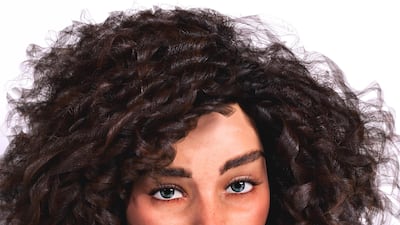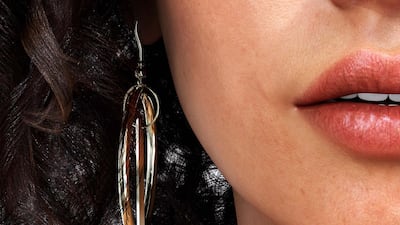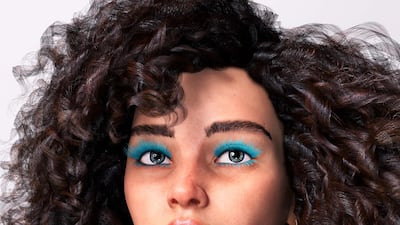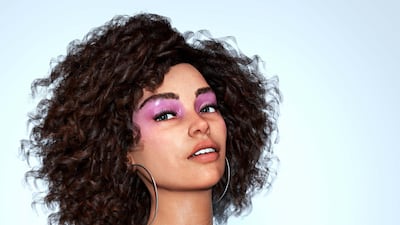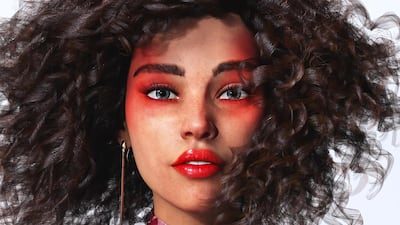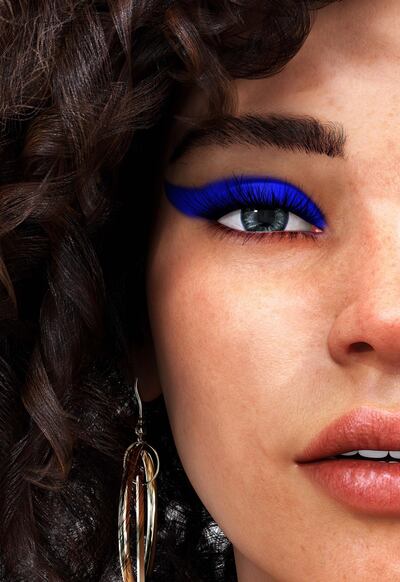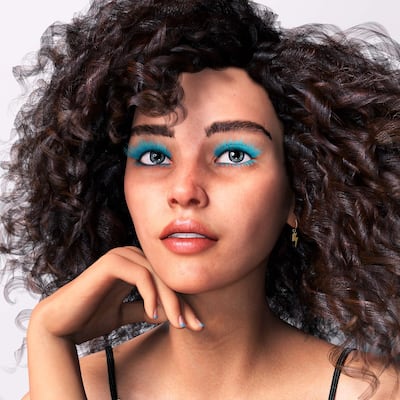Zoe Dvir has blue eyes and a mass of dark corkscrew curls. She is a vegan, an avid supporter of women's rights and democracy, and has aspirations to be a social media influencer.
She is also not real.
Zoe, who starred in the November issue of The National's Luxury magazine, is an entirely digital persona, constructed not for fun, but to attract a following.
“Zoe was created by an Isreali entrepreneur who has been involved with the Isreali tech scene for years," explains Iban Schmorak, head of business development at Zoe01, the company that created Zoe.
"He took his daughter to an influencer conference in the mall one day. He saw teenagers running after people he had never heard of, and he realised there was a whole industry. Normal start-ups have business teams, but Zoe has a team of experts in art, styling and social media, as well as computer engineers.
“She isn’t based on anyone specific, but on the projections of our designers and experts to create someone who will be followed,” explains Schmorak.
The only exception is her mane of corkscrew curls. “Her curly hair is because the creator's daughter has curly hair.”
Zoe Dvir makes her UAE debut
One of a trio of avatars created in Tel Aviv, Zoe Dvir recently "arrived" in the UAE. Eager to tap into the vibrant UAE market, Zoe01 reached out to Dubai modelling agency MMG, which promptly signed Zoe to their books. Just a few day later, she bagged her first job with The National's Luxury magazine.
First things first: how does one address an avatar? She? Her? It? To prescribe gender to an entirely fabricated invention feels a little strange, but so too does calling a human face – albeit digitised – a "thing".
Schmorak sheds some light on the matter. “She is called she. We always joke in the company when she is very busy that ‘she will be too tired with all the flying’, so she is definitely a she, not an it.”
Although Zoe is the first of her kind in this region, she is not alone on the global stage. Invented in 2016, the first virtual personality was Miquela Sousa, or Lil Miquela, created by Trevor McFedries and Sara Decou. Conjured to be the first virtual influencer, her entire look and personality was built to fit seamlessly into Instagram.
Described as a 19-year-old Brazilian-American, her 2.8 million followers can watch her learn to skateboard or drink her favourite coffee. She has released songs on Spotify (one of which, Speak Up, has had 5.5 million views on YouTube), and is feted by top brands such as Chanel, Fendi, Burberry and even Prada, for whom she promoted a series of gifs for Milan Fashion Week.
Shudu the virtual supermodel
Then there is Shudu, dubbed the world's first virtual supermodel and created by ex-fashion photographer Cameron James-Wilson. A white British man, he created a digital woman of colour, after becoming disillusioned with the fashion industry.
Quickly hailed as the world's most beautiful woman (viewers thought she was a real person), she was snapped up by Balmain's creative director Olivier Rousteing, to front the brand's September 2018 advertising campaign. In 2019, she even appeared on the BAFTA red carpet wearing a custom Swarovski gown.
Of course, the advantage of a virtual model is that she always looks amazing, will wear whatever you want her to and there is no unpredictable, human behaviour to contend with. She will never arrive late, never get sick, and never age. Case in point, Lil Miquela is still 19, despite making her debut four years ago.
Another very real hurdle that digital models have been able to overcome is the pandemic. While many people around the world have faced restrictions in movement, and the fashion industry (among others) has ben thrown into turmoil, avatars can be transposed to any location without the need for quarantine or PCR tests.
Hauli travels the world
For its winter 2020 haute couture collection, the Australian/British fashion house Ralph & Russo created a campaign that had a virtual model, Hauli, visit the seven wonders of the world. Captured in front of the Taj Mahal in India, at Petra in Jordan and even atop the Great Wall of China, clad in heart-stoppingly beautiful Ralph & Russo gowns, the whole campaign was impressive even by haute couture standards.
Even without Covid 19 restrictions to contend with, sending a team of ten (a photographer, model, stylist, hair and make-up people, plus assorted assistants) to seven different global locations would have been no easy undertaking.

Schmorak admits that while the pandemic has been tough, it has opened people's eyes to new solutions.
“Covid has affected the world economy, and when private spending on the stuff we advertise goes down, it affects a brand’s willingness to invest money in something innovative, and be early adoptors. But, all of a sudden, we don’t have to justify our product the way we did before, and now people come to us, instead of us running after people.”
He is adamant that the field of virtual fashion models is in its infancy, and will only grow from here. “Zoe is evolving. What started as the technology behind Pixar movies now runs these entities, and allows us to save precious time, and therefore money.”
Watching as fashion shows were halted across the world, Schmorak feels companies like Zoe01 offer feasible solutions for the industry, at a fraction of the cost. “Fashion shows could not be held, photoshoots could not take place. But we don’t even need the clothing to be made – we just need a picture of the back and front and then it can be immediately put onto one of our virtual models.”
This may all seem outlandish, but as an industry, fashion prides itself on pushing boundaries and challenging norms. Through vivid, theatrical shows, it offers moments of fantasy, made real. A case in point was Gucci's February 2018 show, which saw models carrying startlingly realistic copies of their own heads under their arms, along with tiny, sleeping reproductions of baby dragons.
If we are invited to suspend disbelief and welcome dragons on to the runway, who is to say that we cannot go in the other direction, and accept women made of computer code as flesh and blood?
Yet this world of illusions is far from being issue free. Shudu’s creator has drawn intense criticism for cashing in on black women, without having to actually pay any, while Lil Miquel became embroiled in a scandal when she appeared in 2019 alongside the very real Bella Hadid in a campaign for Calvin Klein. Slammed for its risqué nature, the images were pulled and Calvin Kelin was forced to apologise.
“Of the world of influencers as a whole, some say this is a ‘dark’ industry, so adding a virtual layer makes it even darker. When I mention it, people often say: ‘This is Black Mirror stuff,'” admits Schmorak.
“So we approach everything with the maximum delicacy, and we are always considering body image and body objectification and what message do we want to send? Most influencers cover fashion, travel or lifestyle, but we also deal with voting rights, women’s right and the right to protest.
"If you look at Zoe’s Instagram page, you can see she voted, she cares about BLM and we want her involved because there is great power. We deal with that in every post we upload, and we do not accept every project.”
Will these virtual creations eventually replace a flesh-and-blood models altogether? With the fashion and magazine industry already in array due to the pandemic, will people have to face another threat to their livelihood from a virtual being?
When asked if figures like Zoe are the future, Schmorak is quick to point out the reality of the situation. “Zoe is a part of the future. We work a lot with model agencies and everytime I get the same question. Is she going to take my job? The answer is a big no. We are not going to replace anyone, we are just getting into this industry, and there is enough for everybody.”
“When someone chooses to have a virtual model, they are saying: ‘I am innovative, I want to do something new, and I want to keep it safe.’ They are not saying they want to have a virtual model instead of a real person. That’s not possible. We are not trying to fool the customer; consumers are smart and can tell when they are looking at a real person and a virtual one.
"But what I like, is that when people look at Zoe’s Instagram, they scroll and look and then ask: ‘Is she not real?' That is the question that we want to be asked.”
